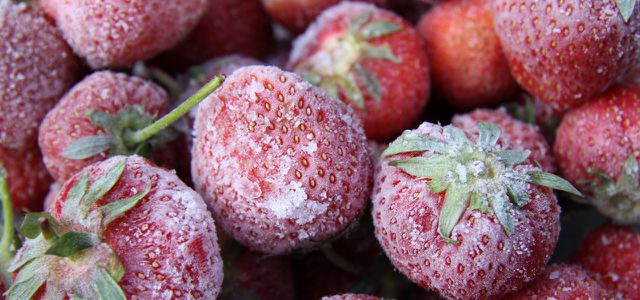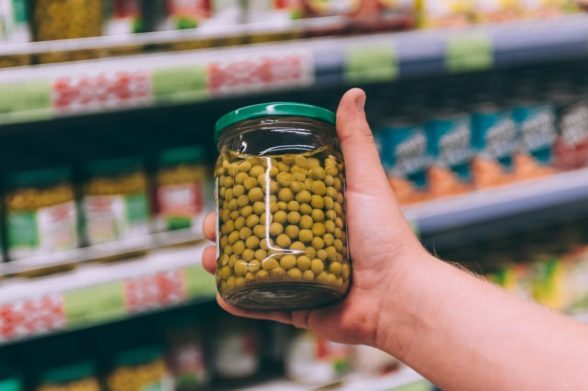Seasonal fruit and vegetables are healthy and also environmentally friendly. But what about frozen food and tin cans? Which preservation method is the gentlest for vitamins and minerals – and therefore the healthiest? Which method is the most environmentally friendly?
Healthy Eating: Frozen or Canned?

Freshly harvested fruit and vegetables contain a particularly large number of important nutrients. However, vitamins – such as vitamin C – are very sensitive to light, heat and oxygen. For this reason, fruit and vegetables should not be transported over long distances and should be eaten as fresh as possible. But what happens to the nutrients when they are preserved by freezing or in the can?
When processed into frozen food, fresh fruit and vegetables are frozen just a few hours after harvesting. This has clear advantages: The levels of minerals and vitamins are still very high and remain largely intact even when temperatures are consistently below zero.
A study by the University of Hamburg shows that the vitamin C content of raw peas was already significantly reduced after seven days of storage at room temperature, while the content hardly changed after two years of deep-freeze storage at -25 degrees (study pdf).
Another plus point: Frozen fruit and vegetables do not contain any preservatives. Frozen food – at least if it is not frozen ready meals – does well from a health point of view, but what about canned foods?
Compared to fresh or frozen products, jarred or canned fruit and vegetables have a lower nutrient content: they are heat sterilized to kill microorganisms and inactivate enzymes.
This preserves the product, but important nutrients such as heat-sensitive vitamins suffer. In addition, mixtures of water, sugar, acids, herbs and sometimes additives are usually added.
Another aspect that does not speak in favor of the can from a health point of view: Tin cans are usually made of tinplate or aluminum, both metals are stable and protect the food from gases, light and odors.
The inner surface is sealed with plastic so that no metals are released from the can and transferred to the food. However, this plastic coating often contains the harmful bisphenol A (BPA): it is suspected of acting like a hormone in the body.
Frozen or Canned: Which is Better for the Environment?
For a long time, frozen food was notorious for being particularly harmful to the environment: the complex production and energy-intensive storage in the freezer at home cannot be environmentally friendly at all. However, a study by the Freiburg Oko-Institut (pdf) shows that this is not necessarily true.
The Freiburg scientists examined various product groups: rolls, chicken fricassee, peas, pizza and potato pancakes. For all products, the greenhouse gas emissions of the compared variants were relatively close to each other.
The example of the peas shows that the different variants are relatively close together. Canned peas have the best climate balance, while frozen peas are in the middle. However, the results depend heavily on the boundary conditions, for example the storage time in the freezer has a major impact on the overall result.
All in all, our behavior influences the carbon footprint of the peas by around 38 percent: a lot can be achieved through the preparation, storage in the household, washing dishes, the trip to the shop and the choice and setting of the refrigerator.
In the life cycle assessment of chicken fricassee, the frozen product performs better than the unchilled or self-prepared product, which is also due to the industrial preparation in large quantities. But here, too, the values are close together.
The illustration shows that it is not the consumer who has the greatest influence on the result, but the way in which the raw materials are provided. In the case of vegetables, this means cultivation and, in the case of meat, livestock farming. With chicken fricassee, keeping the chickens accounts for around 42 percent of the raw material supply. It is therefore decisive for the ecological balance whether the products are of animal origin and whether the product is composed of many different ingredients.
Our actions have a big impact

The general conclusion of the Freiburg study is: frozen products are no more harmful to the climate than canned products; the recipe and consumer behavior are decisive. The higher the proportion of meat and milk, the greater the “fixed cost share” of the climate impact.
Another study shows how big the impact of our behavior on the carbon footprint of food is:
If a consumer decides in favor of the climate for 1 kg of fresh instead of deep-frozen goods, he saves a smaller amount of greenhouse gas emissions than is caused by a 2 km long car journey.
In other words, driving to the grocery store is “worse” than buying frozen instead of fresh vegetables. In any case, it is worth questioning your own actions. You can make a big difference with these eight tips:
Ditch the car and ride your bike – or, if necessary, use public transport – to go shopping.
Plan your purchases so you avoid food waste and long storage times for frozen products.
Place frozen products last on the belt and get them into your freezer as quickly as possible.
Check: how energy efficient is your freezer?
Only open your refrigerator briefly and let freshly cooked food cool down before freezing.
Follow the preparation instructions on the packaging.
Fresh seasonal products from the region are the best choice.
The less meat and animal products you eat, the better for the environment.
